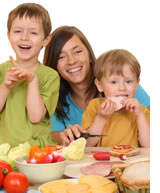
 Creating Peaceful Mealtime Environments
Creating Peaceful Mealtime EnvironmentsThe ideal mealtime environment in a child care service should be a relaxed and pleasurable experience for both the children and carers.
Establishing and maintaining a peaceful mealtime routine requires planning and the introduction of a few simple strategies, hopefully our tips will give you some good ideas as you work towards "mealtime nirvana"!
Children thrive on routine and need to be fed regularly and on time. The food needs to be simple, easy to eat and tasty.
Relaxed meals in the child care environment can help children develop good eating habits for life and may also help children learn to eat when they are hungry and stop when they are full. It also gives children the opportunity to experience a variety of different foods they may not be offered home.
Family style dining; where the food is served in bowls in the middle of the table and everyone helps themselves is a great way of creating a good environment.
Carers should sit with the children and help them serve and in the ideal scenario the carers should encourage the children to practice their manners and engage in conversation.
Family style dining works when:
- Mealtimes are signalled by a transition activity, such as a specific song or activity such as, washing hands or laying the table. Children can become very engrossed in what they are doing making it very difficult to pull them away to eat. A transition activity provides them with the opportunity to refocus on the next part of the day.
- Mealtime routines are consistent and regular. Children have small stomachs and use lots of energy, so ensuring meals are on time will avoid hunger related behavioural problems.
- Children know what to expect and how they should behave. Australian children come from an extraordinary array of different cultural backgrounds with myriad different mealtime traditions. Ensuring children know what is expected from them during mealtimes in your service is very important.
- Supervision is controlled. Some children require more help/supervision than others during mealtime and it is best to position care givers close to these children. Mealtimes will be more pleasant for everyone if you learn to anticipate what assistance children will need before the meal and seat children accordingly.
- Acceptance is given to the fact that young children are still learning how to eat properly and spills are likely to happen on a daily basis. Children should still be encouraged to use cutlery rather than their hands as practice makes perfect!
- Children are permitted to choose what they would like to eat and how much they would like. When children understand that they will not be forced to eat anything they don't want to and when they can choose exactly what they do want to eat they relax. Children who don't eat enough during the designated mealtime will soon learn the error of their ways!
- Children are not rushed through their meal and are able to eat as slowly or as quickly as they like. As long as they understand how long they have to eat and given warning when mealtime is nearly over, most children in a child care environment will follow their peers and tuck in much more readily than they might at home. Everyone should be encouraged to stay at the table until mealtime is over because it creates a pleasant environment for everyone and those who leave the table will miss out on the table conversation.
- Children are asked if they have had enough to eat at the end of a meal and reminded when the next meal is. This will hopefully encourage everyone to eat enough to keep them going. As mentioned above, children who don't eat enough will quickly learn to eat more at the designated feeding times!
- Mealtime conversations are relaxed and light hearted with everyone given the chance to contribute to conversations initiated by either the children or the care givers. Conversation could revolve around the children's interests and experiences, what they did at the weekend what they played with this morning and so on. You could also discuss the food on offer, what it is, what colour it is, whether it is a vegetable, fruit, where it comes from, how it has been prepared, whether the children eat this food at home etc.
The care givers are responsible for:
- Planning and preparing healthy and tasty meals and snacks
- Setting regular times and routines for meals and snacks
- Assuring the children come to the table and stay at the table for the duration of the meal
- Creating a pleasant environment through supervision and conversation
- Deciding which of the tasty and healthy foods on offer they would like to eat
- Deciding how much they would like to eat
- Respecting and adhering to the mealtime traditions of the child care service.
CareforKids.com.au®
Care For Kids Internet Services Pty Ltd
ABN 55 104 145 735
Level 2, 2 Bligh St Sydney NSW 2000
privacy policy contact us